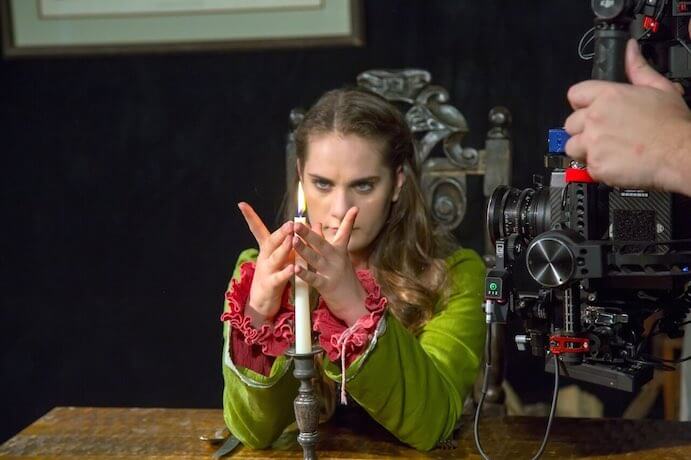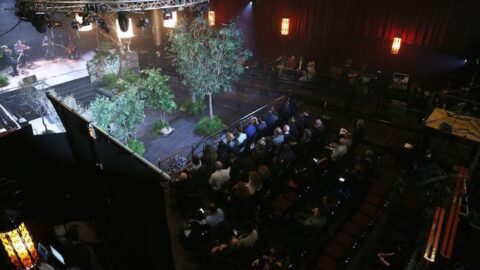When I settled into my seat, pen and taco notebook in hand, to review Lisa Bielawa’s Vireo, I was not wearing pants. I was clad in my “television binge-watching” uniform rather than what I normally might wear while consuming contemporary classical music (e.g. typically an outfit that includes both a top and bottom half). I was also in my living room, feet propped up on the coffee table and glass of wine in hand. Reader, welcome to “television opera.”
A couple of decades ago, composer Robert Ashley envisioned a more accessible, “American” version of opera that could be broadcast on television, pointing out that the history of European opera was literally foreign to Americans, who felt more at home at baseball fields than in opera houses. Ashley wrote a string of “television operas,” which in his words were meant to be “heard and seen by two people sitting on a couch, having a drink, occasionally a snack, occasionally going to the toilet, finally giving up and going to bed because of a hard day of work.” These operas were intended for television, and unlike HD streamings or recordings, were not happening live somewhere else. Sadly, Ashley’s television operas were never recorded or broadcast in the U.S. during his lifetime. But composer Lisa Bielawa–though not directly influenced by Ashley’s television operas–is moving in the general direction of more accessible contemporary classical music with her online opera Vireo, a twelve-episode series concerning itself with witchcraft and time travel, available for anyone to binge-watch via KCET.

The inaccessibilities we typically bump up against in trying to get to the opera are numerous, and in the U.S. these barriers have excluded many demographics from the experience. Not many people can find their way to the Met Opera (and even if they could, it’s not as if the Met has a reputation for programming much in the way of women or living composers). The accessibility of Vireo allows for a fluidity of time and space, not only lending the viewer the capacity to play with time but also allowing for flexibility within the world of the opera itself. Roving camerawork through cavernous and labyrinthine sets demonstrate the depth that is possible when opera is not limited to the stage (and aided by Charlie Otte’s excellent direction). And a similar temporal limitlessness is realized as the plot skips and jolts in time, from Alcatraz to Sweden: the fourth episode, “Beginner,” skips around from 1893 to 1590, with as much ease as a viewer like myself, sitting at home on their sofa, can click from episode to episode, pause, start over. Erik Ehn’s witty, at times bizarre libretto for each episode is available via KCET as well, freezing all these scattered moments in time.
Cuts and leaps through time and space are indicated with sound and color; in episode six, “Boarding School,” these changes are illustrated with shifts in musical tone and from black-and-white to color. In this way the plot, if not always the music, is inextricable from the medium. Bielawa’s music leaps through time in its own way, intertwining traces of Renaissance polyphony with jagged avant-garde lines jolting along in slowly-morphing repetitions. Unusual textures, including those created on Harry Partch’s handmade microtonal instruments, underline the sense of otherworldliness. All musicians carry out the sonic dimension of this “other world” with skill and ease. Soprano Rowen Sabala, only 17 years old when the opera was filmed, handled intricate and erratic vocal lines with ease.

Vireo features the collaborations of dozens of new music groups including Kronos Quartet and Alarm Will Sound, resulting in its own world that Bielawa described as “all-consuming:” “a massive, constantly changing organism with new relationships and energies being created all the time.” The sonic and visual leitmotivic opening, a musical phrase underscoring the title card, heralds the entrance to the world of Vireo, which is defined not only by a fluidity of time and space but also by the surrealism engendered when musicians are glimpsed and even centered within the visual scenes. In the weirdest episode of the bunch, “Cow Song,” a conductor’s hand can be seen bobbing up and down in the corner of the frame as the camera moves from inside to outside. In another episode, “Girl in the Well,” the musicians of Alarm Will Sound are arrayed in the grass, conducted by Alan Pierson as the plot marches onward and familiarity mingles with fantasy in a sort of operatic magical realism. When musicians are not hidden away in an orchestra pit, the visual spectacle of music-making can be enjoyed, and music itself can be centered, even within such a staggering visual and narrative drama.
























